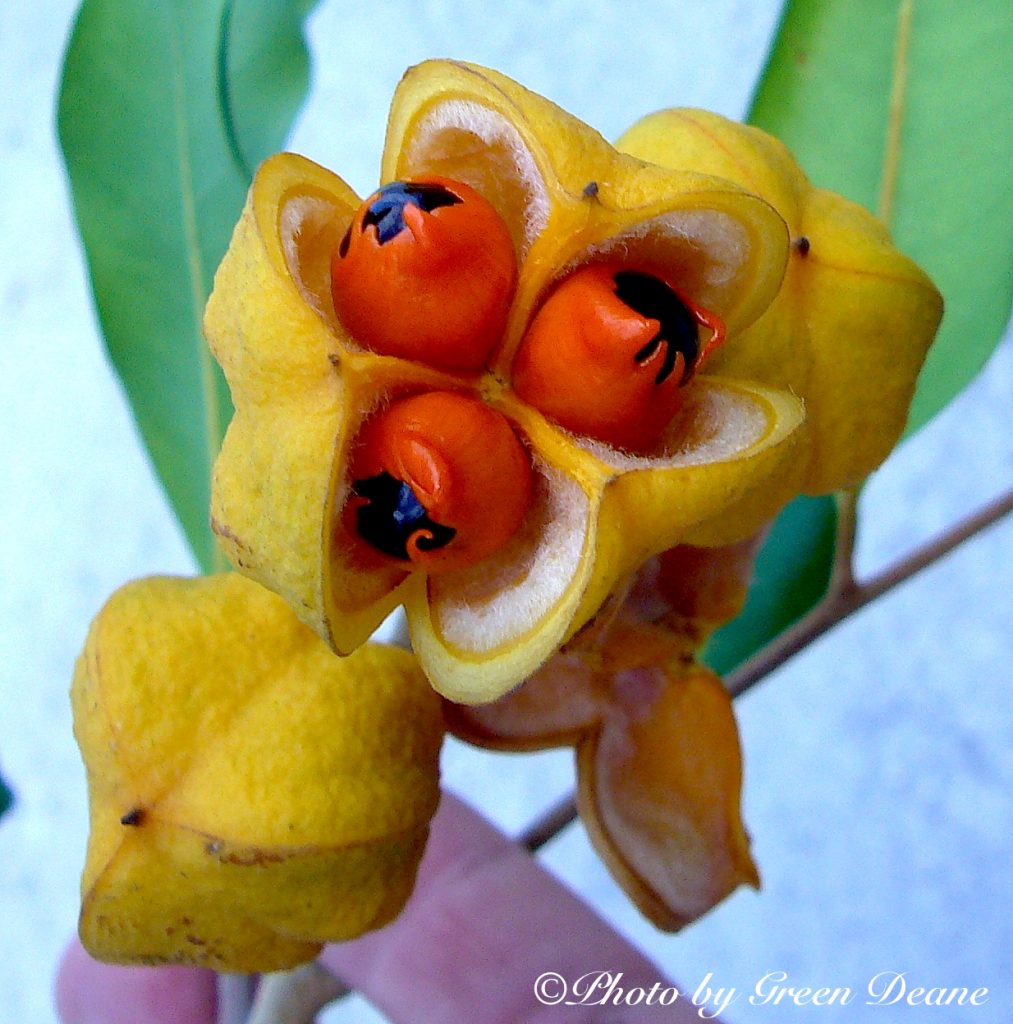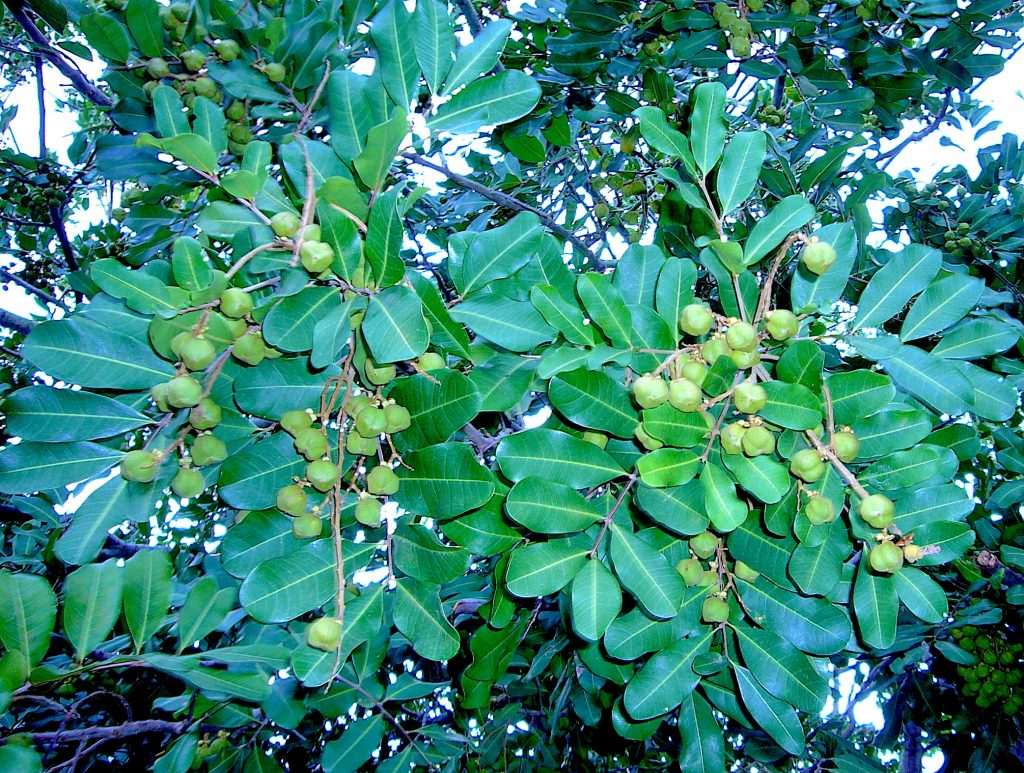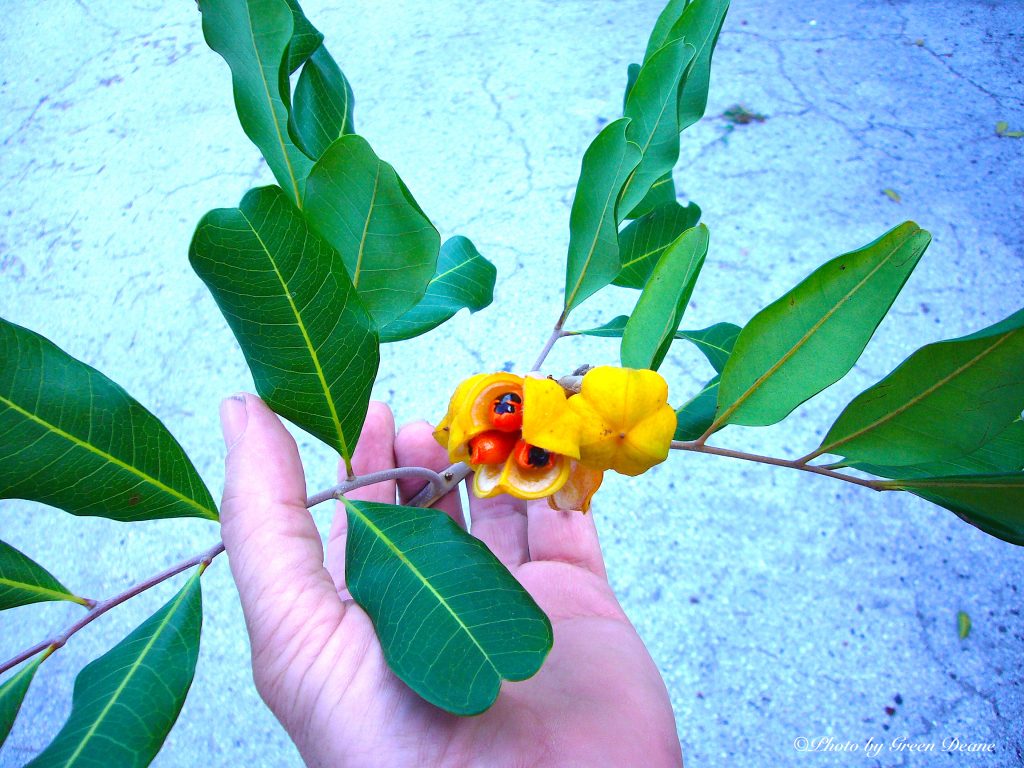
Cupaniopsis anacardioides: An Aboriginal Treat
With a nickname of Tuckeroo, you know the Carrotwood Tree has to be from Australia, and it is. What foraging books in this hemisphere won’t tell you is that part of the ripe fruit is supposedly edible. (Many thanks to Lee Etherington at the www.bushtuckershop.com for doing some original Australian research for me. Please visit their site and watch the Bushtucker Man videos.) That said, not all opinions agree on aril edibility and at least one source says the arils are not edible.

Several governmental sources in Australia say the Aboriginals did indeed eat the ripe aril, some say it is toxic. I found it nearly tastless but it burns my mouth and upsets my stomach. I’m not sure how the Aboriginals considered it a treat. Perhaps I am missing a bit of information. In Australia the tree is also called the Cupania Tree and the Beach Tamarind. Botanically it is the Cupaniopsis anacardioides (koo-pan-nee-OP-sis an-nuh-kar-dee-OP-sis )

One can find a lot about the evergreen C. anacardioides on the internet because it is on Florida’s hit list of invasive gawd-awful weeds. (I am beginning to suspect the best place to find edibles is on your state’s official weed list.) The fruit starts out green then turns bright yellow. It’s a common tree on the east and north coasts of Australia and was imported in the 1960’s to Florida, Texas and California for landscaping. It has not become a pest in California. What caught my eye the first time I saw them was the distinctive shape of the fruit, three lobed comprised of six segments.
The tree’s status in Florida brings up several issues. You cannot own the tree without a permit, the state considers it so bad. Birds, of course, don’t apply for permits to eat the fruit. But then the political correctness kicks in. The state says there is no use for the tree. That is quite false. The wood is favored by wood turners and pricy. Seems to me cutting down the trees for turning reduces the population and generates income. The state just needs to sell the permits to harvest them.
Although called the Carrotwood Tree it wood is actually apricot to pink, close-grained and very tough. It has been used for lumber as well as turning. The tree can grow some 80 feed hight and two feet through at the butt. Locally they are half that height and 20 inches thick.
Cupaniopsis means resembling the genus Cupania (which is named for Francesco Cupani, an 18th century Italian monk and natural scientist who wrote Hortus catholicus and is famous for his work with Lathyrus odorata.) Anacardioides means resembling Anacardia (the genus name for Cashew.) Two resemblances…. they must of run out of ideas that day. Several plants are called “tuckeroo” in Australia so make sure you have the right Tucheroo, Cupaniopsis anacardioides.
One quick identification of the tree is the leaves are spatulate with a bit of an indentation at the end, and each branch ends in a pair of leaves slightly off set (whereas the Jambul tree end leaves are an equal pair.)
You can find them mid-state and south.
Green Deane’s “Itemized” Plant Profile
IDENTIFICATION: Small to medium tree to 30 feet. Leaves compound, 4-11 leaflets, glossy-green, obovate to oblong, 5-15 cm long, 2-6 cm wide, end two leaves are always form a pair. Flowers yellowish, occurring in winter. Fruit orange, 15-30 mm diameter, short-stalked, three-segmented woody capsules up to 0.9 inches across that are yellow-orange when ripen and then dry to brown before splitting open to reveal three black seeds each covered by a yellow-red crust.
TIME OF YEAR: Flowers in Florida in late winter or early spring, January and February, with fruits maturingin April and May depending upon location, sooner farther south, later farther north.
ENVIRONMENT:Spoil islands, beach dunes, marshes, tropical hammocks, pine lands, mangrove and cypress swamps, scrub habitats, and coastal strands.
METHOD OF PREPARATION: Ripe aril eaten raw, not the seeds, not the pulp. I know one source says the arils are not edible. I don’t eat them.


Holy cow iwas just telling my wife I need to know what kind of tree this was they plant them in parking lot planter boxes down here in martin county. I’ve always seen the fruit closed and green but it’s deff the tree. At least I know what to call it and I have a wood lathe so I’ll let you know how it turns. Thanks again for naming all these mysterious trees i walk by daily
Makes a great wood for walking sticks. Scrape the bark, stain and poly them. Gets rid of an invasive, and gives it new life.
Might have to try this wood for some bow staves. I’ve got a few of these trees in my yard that need to get cleared.
They grow well in San Diego in either decomposed granite or clay. Not a problem being invasive but the mexican landscapers hate the seeds because they are hard to walk on, like walking on marbles I was told but I never had a problem other than the lawn mower likes to shoot them across the yard lol – so use a bagger on your mower.
By aril, do you mean the orange part, or the white spongy stuff under the yellow outer covering? And by inedible, do you mean toxic or just icky-tasting?
I just ate one, and it tastes bitter, to where I spit it out (the red part and the seed).
– SCK
In the Southern California costal region wild parrots feast on the nuts/berries of the carrotwood trees in the late spring and early summer. The trees appear to provide a major food source for the wild parrots (There is an unresolved debate as to whether the wild parrots migrated from Mexico due to loss of habitat or are the escaped descendants of pets) in Southern California.
They are easy to cut with a hand saw so if at least pruned properly (taking the bigger of two throughout the tree, your garden will be better off. crow’s may be seen trying to get something out of the big mess of fallen fruit.
My advice is to not eat anything without checking with First Nations people how to prepare. They had/still have very sophisticated ways of preparation and then subsequent use.
Generally, the PULP of the fruit is what you eat, apparently. Considered a great delicacy. I haven’t tried it, yet though.
Hmmmmm… I have only read about the aril. As there are plenty of the trees here I will try the pulp this spring… carefully….
We live at Wollongbar in Northern NSW, Australia, some 20klms from the coast. These trees are native to our area which is warm temparate,
average rainfall 60 inches per annum. Hope this helps. Pre settlement the area was a cooastal rainforest as the soil is red kraznozem volcanic, red and deep. Hope this helps.
We have 9 of these trees around the yard, mainly for shade and bird life. Haven’t really seen birds eating the fruit, even though they say there bird attracting. They look amazing, great shade, we live in Adelaide, South Australia. We are thinking of putting more around the yard. Ours are between 4&8mtrs tall.
These were planted as part of an all native garden at a property I lived at in Blackwater, Qld. They fruited profusely bringing in many birds including: Australasian Figbird, Silver-eye, Brown Honeyeater, Blue-faced Honeyeater, Crested Pigeon, Peaceful Dove, Rainbow Lorikeet, Striped Honeyeater, Sulphur-crested Cockatoo, Little Friarbird and Olive-backed Oriole. Their fallen seeds were quite a nuisance to walk on, requiring regular sweeping up.
I was wondering about how much debris they left on the ground, I suppose the birds eating the seed would do that. How much mess do they create?
For a while each year they are a messy tree.
I have several carrotwood trees 8-12 inches diameter, and wondering if roots will damage a concrete patio or get into sewer pipes? Otherwise they are great for shade, grow straight, and very fast! Thanks folks! BovinaMcKinney@gmailREMOVETHIS.com
It may not be officially considered a pest in Southern California, but it spreads prolifically around the shopping centers where it is used as landscaping.
I am sure it won’t out-compete native species, because it doesn’t create enough shade or litter to smother the local population. I have coast live oak and island gooseberry (both of which need shade to get started) growing under one of the carrotwoods self seeded in my yard, and it’s obvious that in a very few years, the oaks will crowd out the invader.
This tree is planted in San Gabriel Valley, Ca as an ornamental shade tree on parkways. They are gnarled and light colored with a semi smooth bark. In my observation they grow quickly, requiring regular pruning and removal of suckers by the city. The seed pods are messy and the shells/pods are hard, and don’t decompose or disperse easily. As such, they must be removed to prevent impeding the sidewalk. It propagates extremely easily and in large numbers, so not surprising that it is potentially invasive.
Thank you. It took me an hour with Google lens to identify this tree and I knew you would have something on it. Mine is flowering and the birds love it. I thought of your shows and said I bet I could eat that. I won’t but I also read that it was used by the Aboriginal people as medicine for the stomach, and it is supposed to have weight loss properties. I’m guessing, haven’t tried it, that it probably fushes you out. The seed pods are pretty. They look like little wooden flowers. I will keep them in a basket as a decoration.
Thanks for enlightening me.
I have two of these trees in my yard in Northern New South Wales, Australia.
I was told by a friend they were Macadamia trees and I thought something was wrong with the fruit.
Now I know they are not Macadamia.